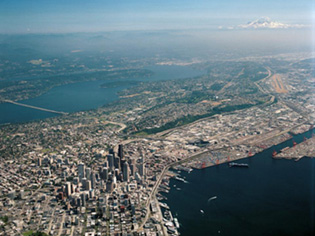Modeling the Interactions Among Urban Development, Land Cover Change, and Bird Diversity
Investigators: Marina Alberti (PI), Paul Waddell, John Marzluff, & Mark Handcock
Project Description: 
The interactions between urban development and ecological processes are extraordinarily complex. Urban development evolves over time and space as the outcome of interactions between individual choices and actions taken by multiple agents. These decisions affect ecosystem structure and functions through the conversion of land, fragmentation of natural habitat use, disruption of hydrological systems, and modification of energy flow and nutrient cycles. Environmental changes at local and regional scales affect human well-being and preferences, and thus the decisions people make (Alberti and Waddell 2000).
As part of the Biocomplexity I project. we developed a model of Puget Sound land cover change, which was integrated with a model urban development. The focus of this project is on linking urban development to bird diversity through land cover as a test case for an integrated modeling approach. This approach builds on model traditions in urban economics, landscape ecology, bird population dynamics, and complex system science, each of which offers different perspectives on modeling urban ecological interactions. The project explores Bayesian networks and a multi-agent microsimulation approaches for their potential to support complex inference modeling in problem domains with inherent uncertainty. In the long term, we aim to understand how best to model complexity and uncertainty of coupled socioeconomic and biophysical processes in metropolitan regions and their interactions with the policy domain.
A major challenge in modeling urban landscape dynamics is in representing explicitly the human and biophysical agents at a level of disaggregation that allows us to explore the mechanisms linking patterns to processes. The interactions between human and natural systems occur simultaneously at different levels of organization. This project is a first step in linking a microsimulation of human behaviors and spatial explicit landscape to simulate the dynamic interactions between urban development and ecological processes and its impacts on habitat for birds.
Our explorations of the relationships between urban development, land cover change, and bird diversity provide important insight for modeling human dominated landscape dynamics. Multiple agents interact with biophysical processes producing a variety of landscapes in urbanizing environments which influence ecological dynamics in different ways. Landscape change resulting from these interactions affects the diversity of birds by favoring some species over others and creating new interactions in processes such as competition, predation, and diseases. Changes in landscapes also affect humans and the choice for their housing location. People’s preference for the presence of forest is shown by the effect of forest on housing prices. Many attributes of the landscape, both composition and configuration, are correlated with land cover change. These findings provide an initial test for the development of model specifications that can effectively couple human and ecological processes in human dominated landscapes.
Sub-projects:
Microsimulation of the Urban Development Process
Land Cover Change Model
Biological Diversity Modeling
Publications:
Alberti, M. 2008. Advances in Urban Ecology: Integrating Human and Ecological Processes in Urban Ecosystems. Springer-Verlag.
Liu, J., Dietz, T., Carpenter S., Alberti, M., Folke, C, Redman, C., Schneider, S., Ostrom, E., Pell, A., Lubchenco, J., Taylor, W., Ouyang, Z., Deadman, P., Kratz, T., and W. Provencher. 2007. Complexity of coupled human and natural systems. Science 317(5844): 1513 – 1516.
Liu, J., Dietz, T., Carpenter S., Folke, C., Alberti, M., Redman, C., Schneider, S., Ostrom, E., Pell, A., Lubchenco, J., Taylor, W., Ouyang, Z., Deadman, P., Kratz, T., and W. Provencher. 2007. Coupled human and natural systems. Ambio. 36(8): 639-649.
[project_list page=”1157″]